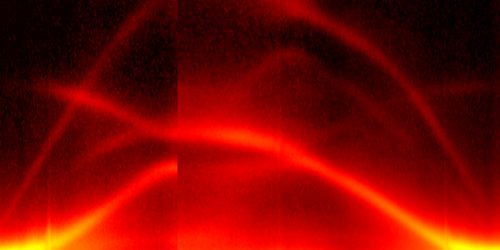Graphene Has Topological Phonons
When atoms crystallize, their energy levels split to fill wide bands. That spreading of the levels sets the crystal’s electronic properties, but it’s not the only factor. How the atoms arrange in space also counts, and in some rare cases, a crystal can possess certain symmetries that bestow the bands with “topological” features. Like electrons, phonons move about a crystal in ways prescribed by a band structure, which can also have topological features. Now, Jiade Li of China’s Institute of Physics and his collaborators have used a type of electron spectroscopy to demonstrate that graphene, which has already been shown to have topological electrons, has topological phonons [1].
Some interesting properties of topological materials, such as the hosting of dissipationless surface currents and of Majorana quasiparticles, are immune to impurities, defects, and other local perturbations. That’s because they derive from the band structure’s global topology and not from its local topography. To map graphene’s entire phonon band structure, Li and his collaborators used a technique that measures the energy lost by electrons as a function of momentum as they bounce off a surface. Electrons that encounter a resonant phonon lose more energy.
The team’s detailed map contains two types of topological feature—Dirac points and nodal rings—which appear at locations where the phonon bands cross. The coincidence of the crossings and the topological features do not necessarily signify the presence of topological phonons. But Li and his collaborators are confident that they’ve seen them because of their map’s close resemblance to one derived from theory [2]. The researchers’ next goal is to detect topological phononic edge states, which they say could be harnessed to make phonon diodes and other “phononic” devices.
–Charles Day
Charles Day is a Senior Editor for Physics Magazine.
References
- J. Li et al., “Direct observation of topological phonons in graphene,” Phys. Rev. Lett. 131, 116602 (2023).
- J. Li et al., “Topological phonons in graphene,” Phys. Rev. B 101, 081403 (2020).




